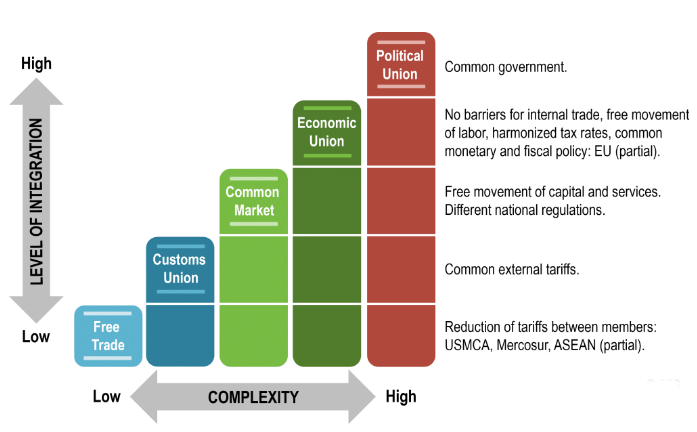Levels of Regional Economic Integration | Crash Course for UGC NET Commerce PDF Download
Levels of Regional Economic Integration

Understanding the different levels of regional economic integration helps clarify how many stages exist and their characteristics. Here’s a detailed breakdown:
Preferential Trading Area (PTA): In a PTA, countries agree to lower tariffs and quotas on imports from fellow member countries while maintaining their individual trade policies toward non-member nations. Cooperation is minimal, and no formal institutions are established. Examples include the ASEAN Free Trade Area and the Latin American Integration Association.
Free Trade Area (FTA): Member countries in an FTA remove all tariffs, quotas, and non-tariff barriers on trade among themselves but retain their independent trade policies toward non-members. Common rules of origin are established to prevent trade deflection, and a legal and institutional framework is created. Notable examples are NAFTA and Mercosur.
Customs Union: A customs union expands on an FTA by implementing a common external tariff and a unified trade policy toward non-members. This integration allows for coordinated trade planning with outsiders. An example is the European Coal and Steel Community, which evolved into the EU customs union.
Common Market: Beyond a customs union, a common market allows the free movement of factors of production—such as labor, capital, services, and technology—across borders. It includes institutions that regulate competition and coordinate macroeconomic policies. Examples include the EU common market and the European Economic Community (EEC).
Economic Union: In an economic union, members achieve full economic integration with a single market, coordinated fiscal, budgetary, and monetary policies, and possibly a common currency. This stage allows for harmonized policies across the entire region. The EU is working towards a fuller economic union.
Complete Economic Integration: This highest level of integration involves both economic and political union, with member countries ceding national sovereignty to supranational institutions. A permanent legal and institutional framework is established. Federal states like the US or specific autonomies within countries are examples of this level, and the EU approaches this in some aspects.
Stages of Economic Integration
The stages of economic integration reflect a progression from basic cooperation to full unification:
Preferential Trade Arrangements: Countries agree to reduce tariffs and quotas on selected imports from member states while keeping their trade policies toward non-members unchanged. This stage has limited institutional framework and is a simple way to explore trade integration benefits.
Free Trade Area: Members eliminate tariffs, quotas, and other trade barriers among themselves but maintain separate trade policies towards non-members. This stage significantly boosts trade volumes by removing barriers but requires more changes to trade policies.
Customs Union: In addition to removing trade barriers, members adopt a common external tariff and a unified trade policy towards non-members. This stage enables integrated planning of trade policy and better utilization of economies of scale, though it necessitates harmonizing external trade policies.
Common Market: A common market allows free movement of labor, capital, goods, and services across borders and requires coordination of competition and macroeconomic policies. It enhances efficiency through specialization and competition but demands coordination of non-trade policies.
Economic Union: Members coordinate fiscal, budgetary, and monetary policies to form a single market, potentially adopting a common currency. This stage allows for macroeconomic stabilization and optimal resource allocation, but requires extensive policy coordination and transfer of sovereignty.
Complete Economic Integration: This stage achieves full economic and political union, with member states surrendering autonomy to a permanent institutional framework. It results in a fully integrated economic region with a unified voice but involves significant transfers of sovereignty.
Conclusion
The levels of regional economic integration reflect a spectrum from minimal cooperation to complete economic and political unification. At lower levels, such as preferential trading areas and free trade zones, countries can test the benefits of trade integration while maintaining separate policies with non-members. As they progress to customs unions and common markets, they harmonize policies and increase mobility. The highest levels, such as economic and monetary unions, require substantial institutional capacity, policy coordination, and political commitment. Nations must balance the trade-offs between greater integration benefits and the loss of sovereignty, ultimately gaining access to a larger market, economies of scale, and enhanced regional cooperation.
|
237 videos|236 docs|166 tests
|
FAQs on Levels of Regional Economic Integration - Crash Course for UGC NET Commerce
Ans. The different levels of regional economic integration include preferential trading agreements, free trade agreements, customs unions, common markets, economic unions, and complete economic integration.
2. What is the main goal of regional economic integration?$#
Ans. The main goal of regional economic integration is to promote economic cooperation and reduce barriers to trade and investment among participating countries.
3. How do regional economic integration agreements affect member countries' economies?$#
Ans. Regional economic integration agreements can lead to increased trade, economic growth, job creation, and improved efficiency in production among member countries. However, they can also pose challenges such as competition for local industries and loss of sovereignty in decision-making.
4. What are some examples of regional economic integration agreements?$#
Ans. Some examples of regional economic integration agreements include the European Union, the North American Free Trade Agreement (NAFTA), the Association of Southeast Asian Nations (ASEAN), and the Southern Common Market (MERCOSUR).
5. How does regional economic integration impact non-member countries?$#
Ans. Regional economic integration can impact non-member countries by creating trade diversion or trade creation effects, depending on the nature of the agreement and the trade relationships between member and non-member countries.
















